“Big Bend National Park: Nature’s Tapestry of Desert Wonders and Geological Marvels”
Big Bend refers to several geographical locations, but one of the most well-known is Big Bend National Park in the state of Texas, USA. This vast and remote national park is situated along the United States-Mexico border and is renowned for its stunning landscapes, diverse ecosystems, and unique geological features.
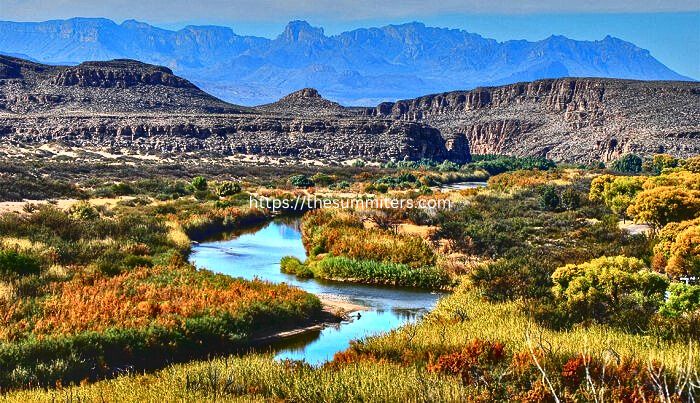
Geography and Landscape
Explore the captivating world of geography and landscape within Big Bend National Park where nature unfolds in a breathtaking tapestry of wonders. Stretching across more than 800,000 acres along the United States Mexico border, the park reveals a diverse array of terrains to captivate the senses. The Rio Grande River gracefully winds its way through the arid Chihuahuan Desert shaping the park’s southern edge and creating a striking interplay between lush riparian areas and the expansive desert surroundings. Majestic mountains epitomized by the Chisos range, provide an awe inspiring backdrop to the sprawling desert flats. This intricate choreography of canyons mountains and desert landscapes positions Big Bend as a singular showcase of geographical richness inviting eager explorers to venture into its varied terrain and uncover the captivating geological marvels that define its character.
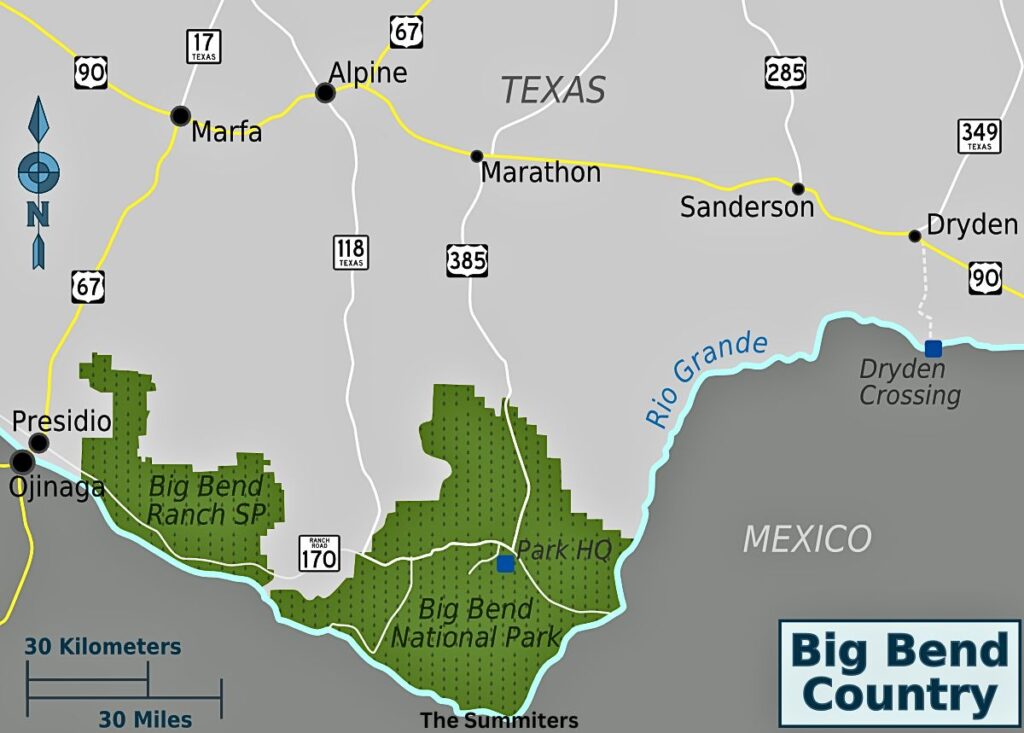
The landscape of Big Bend is incredibly diverse, featuring deep canyons, high mountains, and expansive desert flats. The Chisos Mountains, located in the heart of the park, offer a striking contrast to the surrounding desert and are home to some of the highest peaks in Texas.
Flora and Fauna
The complex tapestry of flora and fauna Big Bend National Park emerges as a flourishing sanctuary for biodiversity showcasing a remarkable diversity of plant and animal life across its expansive terrain. Despite the arid challenges of the Chihuahuan Desert the park nurtures a resilient array of flora where cacti and succulents adapt to the harsh conditions and the Rio Grande breathes life into thriving riparian habitats. Beyond the botanical marvels the park provides a refuge for various wildlife including the iconic roadrunner elusive mule deer and the animated javelina. Enthusiasts of avian wonders are treated to a vibrant spectacle with golden eagles peregrine falcons and the graceful presence of hummingbirds decorating the skies.Big Bend serves as a testament to nature’s remarkable ability to adapt and prosper presenting a captivating panorama of life against the rugged backdrop of the Chihuahuan Desert.
Geological Wonders
Embark on an extraordinary adventure through the geological be surprised of Big Bend National Park where each rock and canyon narrates a captivating tale of Earth’s intricate history. This expansive natural haven reveals itself as a rich treasure collection showcasing awe inspiring formations that eloquently testify to the formidable forces shaping the region over countless millennia. Find yourself standing at the edge of Santa Elena Canyon where towering limestone cliffs provide a dramatic testimony to the unstoppable erosive power of the Rio Grande, carving its way through the landscape with breathtaking force.
Meanwhile the Chisos Basin cradled amidst lofty peaks unfolds a geological drama of uplift and erosion showcasing the dynamic processes that have shaped these high altitude landscapes.
Fossilized remnants from ancient marine life add a compelling layer to the narrative narrating stories of a distant era when the region lay submerged beneath vast seas.
Big Bend is more than a geological marvel.
it’s a living museum beckoning curious visitors to witness the ongoing interplay of natural forces that continue to meticulously sculpt its diverse and breathtaking terrain.
The park also boasts fossilized remains of ancient marine life, evidence of a time when the region was covered by a vast sea.
Recreational Activities
Discover a quantity of entertaining opportunities amidst the natural impressiveness of Big Bend National Park. The park boasts a contrastive range of activities to cater to various interests and preferences. Roam through hiking trails that wind amidst canyons and mountainous landscapes providing stunning vistas of the surroundings. The Rio Grande extends an invitation for water based adventures with opportunities for river rafting and canoeing adding an exhilarating dimension to the experience. Moreover the expansive night skies above Big Bend recognized as a Dark Sky Park create a mesmerizing backdrop for stargazers and astronomers to delve into celestial wonders. Be it hiking rafting or stargazing Big Bend National Park ensures a fulfilling and immersive experience for nature enthusiasts seeking different ways to connect with the splendid outdoors.
Cultural and Historical Significance
Exploring the Cultural and Historical weightiness of Big Bend National Park reveals a captivating narrative woven into the tapestry of the American Southwest. This expansive and rugged terrain carries the imprints of centuries, with traces of human presence be stretchy back thousands of years. The cultural heritage is richly adorned by the stories of Native American tribes, Spanish explorers, and Mexican settlers who have all contributed to the area’s unique identity.
Explorers can traverse historic sites such as Castolon a former trading post that once served as a crossroads of diverse cultures. Meanwhile the Hot Springs Historic District provides insight into more recent history, with thermal springs that have attracted people for centuries.
Big Bend stands as a living testament to the diverse cultural influences that have shaped its profound history, making it an enthralling destination for those eager to connect with the cultural and historical roots of the American Southwest.
History
Before 1535, during the early historic period, various Indian groups inhabited Big Bend, contributing to the region’s cultural diversity. The Chisos Indians, a nomadic group practicing limited agriculture, were linguistically associated with the Conchos Indians. The Jumano, another nomadic group traded throughout West Texas and southeastern New Mexico but had historical conflicts with the Chisos. In the 18th century the Mescalero Apaches displaced the Chisos Indians, and the Comanches were among the last Native American groups to traverse Big Bend. The European presence began in 1535 with Spanish explorations searching for resources and establishing centers for evangelization. In the late 18th century, presidios were built along the Rio Grande to protect the northern frontier of New Spain. Following the Mexican–American War the U.S. Army conducted surveys in the Big Bend, establishing forts to protect settlers from Indian attacks. African American soldiers, known as “buffalo soldiers,” played a significant role in these forts. Ranchers settled in the area around 1880, leading to overgrazing and environmental challenges. In the late 19th and early 20th centuries, mining operations brought communities like Boquillas and Terlingua. The Rio Grande floodplain saw agricultural settlements with names like Terlingua Abajo, San Vicente, and La Coyota. A notable event in 1916, the Glenn Springs raid, garnered national attention and led to the mobilization of the Texas National Guard. A permanent cavalry camp at Glenn Springs remained until 1920 when the border situation improved.
Cultural resources
Big Bend National Park serves as a remarkable repository of cultural resources that delve into the intricate tapestry of human history spanning millennia. The cultural heritage of the park is interwoven with the stories of indigenous communities such as the Chisos Indians and the nomadic Jumano whose legacies endure through artifacts rock art and ancient dwellings scattered across archaeological sites. As European explorers arrived in the 16th century the Spanish influence left its mark with the establishment of presidios along the Rio Grande in the late 18th century shaping a strategic frontier for New Spain. The remnants of these forts including the Presidio de San Vicente and the Presidio de San Carlos, contribute to the layered cultural narrative of Big Bend. The 19th century witnessed the movement of diverse Native American groups like the Comanches, as well as the buffalo soldiers, African American troops playing a pivotal role during westward expansion. The late 19th and early 20th centuries brought a new chapter with settlers drawn to valuable mineral deposits, resulting in mining communities like Boquillas and Terlingua. Today, visitors can explore these cultural resources, from ancient rock art to remnants of mining operations, offering insights into the diverse historical tapestry of Big Bend National Park. The preservation and understanding of these cultural assets are essential for appreciating the park’s profound significance and ensuring that future generations can connect with the rich heritage embedded in this extraordinary landscape.
Tourism
Big Bend situated as one of the largest most remote and least visited national parks in the contiguous United States has consistently attracted an annual average of 377,154 visitors over the 10 byear period from 2009 to 2019. Its primary allure lies in its extensive network of hiking and backpacking trails, showcasing remarkable landscapes and geological formations. Notable among these trails are the Chimneys Trail, leading to a captivating rock formation in the desert; the Marufo Vega trail, a scenic loop trail navigating canyons along the Rio Grande; the South Rim trail encircling the high Chisos Mountains; and the Outer Mountain Loop trail, a challenging 30-mile route combining parts of the South Rim loop, the Dodson Trail, and the Chisos Basin. Significant landmarks include Santa Elena Canyon, Grapevine Hills, and the Mule Ears rock towers. Professional backpacking guide services offer tailored trips within the park.
Managing 118 miles of the Rio Grande for recreational use, Big Bend allows river exploration, with professional outfitters offering guided tours. Personal boat use is permitted, but participants need a free river float permit. Since June 2009, Homeland Security treats all river float trips as if they left the country, requiring participants to have proper identification for re-entry. Visitors often cross the Rio Grande to visit the Mexican village of Boquillas, a crossing that officially reopened in April 2013 as a Class B Port of Entry between the U.S. and Mexico, operating from Wednesday through Sunday.
Boasting a rich biodiversity, Big Bend’s more than 450 recorded bird species make it a haven for birdwatching enthusiasts during annual migrations. The park features five paved roads, including the Persimmon Gap to Panther Junction road, a 28-mile route from the north entrance to park headquarters; the Panther Junction to Rio Grande Village road, a 21-mile descent from park headquarters to the Rio Grande; the Maverick Entrance Station to Panther Junction road, a 23-mile route from the western entrance to park headquarters; the Chisos Basin Road, a 6-mile climb to Panther Pass before descending into the Chisos Basin; and the 30-mile Ross Maxwell Scenic Drive, leading to the Castolon Historic District and Santa Elena Canyon.
Read Also: Annapurna Winter Expedition Update: Team at Camp 2, Anticipating Camp 3 Ascent Tomorrow
Peaks Around Big bend
Big Bend National Park is home to a diverse range of peaks and mountains, showcasing the park’s rugged and varied terrain. Here is a list of some notable peaks within Big Bend:
Emory Peak
Perched at an impressive elevation of 7,825 feet and 2,385 meters Emory Peak proudly claims its position as the high summit in both the Chisos Mountains and Big Bend National Park. This prominent peak named in honor of 19th century American military officer and surveyor William H. Emory beckons intrepid hikers to start on a challenging yet enriching journey. The ascent unfolds along meandering trails that traverse diverse landscapes ranging from verdant forests to rugged mountainous terrain. Upon conquering the summit adventurers are treated to a sweeping panorama that spans the vast Chihuahuan Desert revealing the intricate beauty of the region. Emory Peak stands not only as a geographical pinnacle but also as a symbol of the park’s allure encapsulating the spirit of exploration that drives visitors to ascend the heights and absorb themselves in the breathtaking vistas of Big Bend.
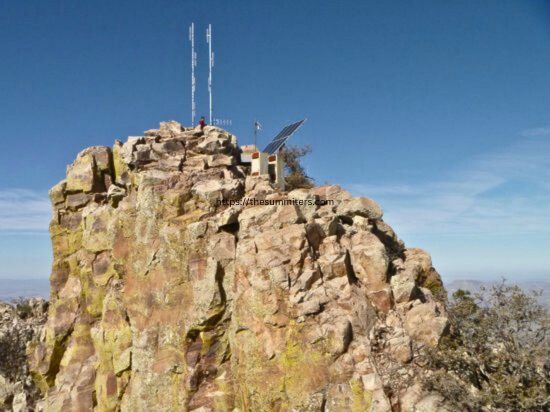
The Summiters of Emory Peak
Herb and Jan Conn: As mentioned earlier, these pioneering siblings made the first ascent in 1945, laying the groundwork for climbing in Big Bend.
Royal Robbins: This legendary figure soloed Emory Peak in 1955, showcasing his exceptional climbing skills and establishing a solo ascent record that stood for decades.
Countless Recreational Climbers: Since then, the Emory Peak Trail has become a popular route for hikers and climbers of all levels, with many reaching the summit and enjoying the spectacular views.
Lost Mine Peak
Lost Mine Peak situated in close proximity to Emory Peak, stands as a attractive companion in the Chisos Mountains of Big Bend National Park. With an elevation of 7,535 feet and 2,297 meters this scenic summit entices hikers with its promise of breathtaking panoramic views. The trail leading to Lost Mine Peak guides adventurers through the rugged and picturesque terrain of the Chisos unveiling a diverse landscape that adds to the allure of the ascent. As hikers rise the sweeping vistas from Lost Mine Peak showcase the vastness of the Chihuahuan Desert below creating a captivating tableau of natural beauty. The peak’s elevation and strategic location within the Chisos Mountains contribute to its status as a vantage point that offers a hypnotic perspective of the park’s stunning topography, making it a must visit destination for those seeking both adventure and awe inspiring landscapes in Big Bend.
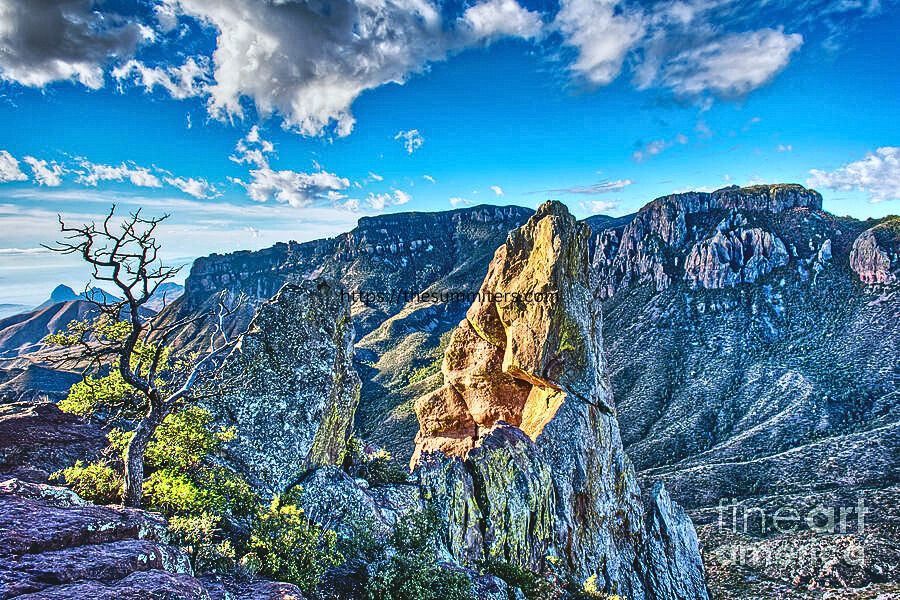
The summiters of Lost Mine Peak
Fred Beckey: Known for his prolific first ascents in the Pacific Northwest, Beckey tackled Lost Mine Peak in the 1940s, leaving behind valuable route information for future climbers.
lly Berg: This Big Bend climbing legend established several routes on Lost Mine, including the challenging North Ridge, inspiring future generations of climbers.
Recent Climbers: The North Ridge and other technical routes on Lost Mine continue to attract experienced climbers seeking a more challenging ascent.
South Rim
The South Rim, though not a singular peak, stands as a distinctive feature within the Chisos Mountains of Big Bend National Park. Drawing enthusiasts with its elevated views and captivating panoramas, this renowned trail meanders through the rugged Chisos landscape, offering hikers a unique vantage point of the surrounding terrain. Unfolding as a series of majestic viewpoints as one ascends, the South Rim unveils the vastness of the Chihuahuan Desert below. Attracting both seasoned and novice hikers alike, this trail provides an immersive experience into the diverse ecosystems of the Chisos, highlighting the unparalleled beauty of the park. Its popularity stems not just from its accessibility but also from the expansive vistas that make it a cherished and frequently explored destination within the park.
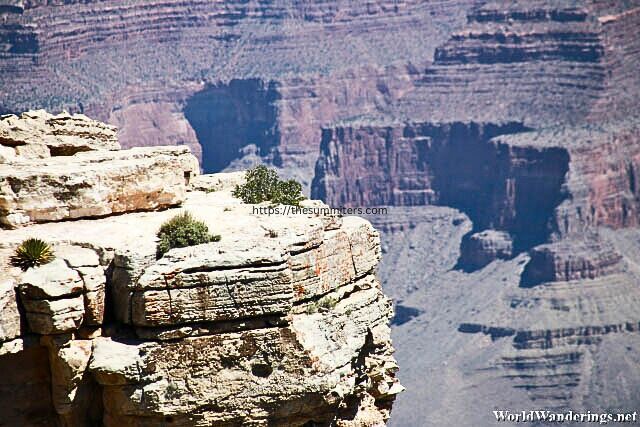
Casa Grande
Casa Grande, a striking rock formation in the Chisos Basin, is frequently misconstrued as a peak owing to its notable height and distinctive appearance. Serving as a prominent landmark within the basin, Casa Grande stands as an iconic feature that captivates visitors with its unique geological characteristics.
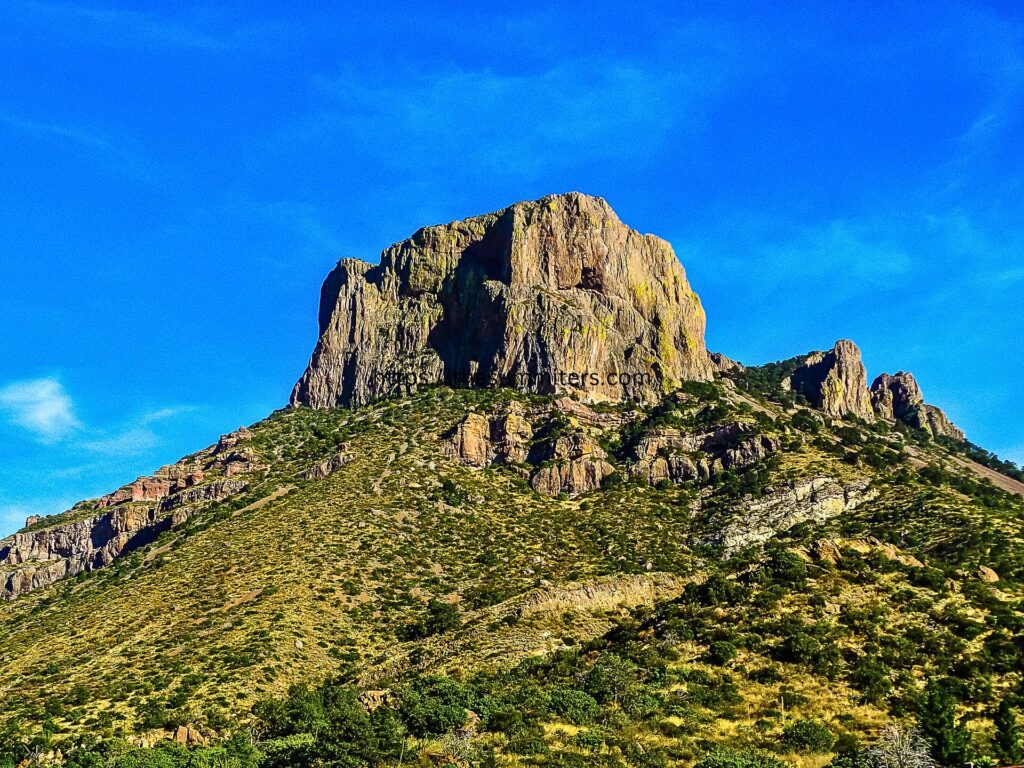
The summiters of Casa Grande
Local climbers: This rugged peak is favored by Big Bend locals and experienced climbers looking for a physically demanding ascent with excellent panoramas. Specific individuals haven’t been widely documented due to the peak’s limited popularity.
Cerro Castellan
Situated in the western part of the park, Cerro Castellan is a striking peak with an elevation of 4,835 feet (1,474 meters).
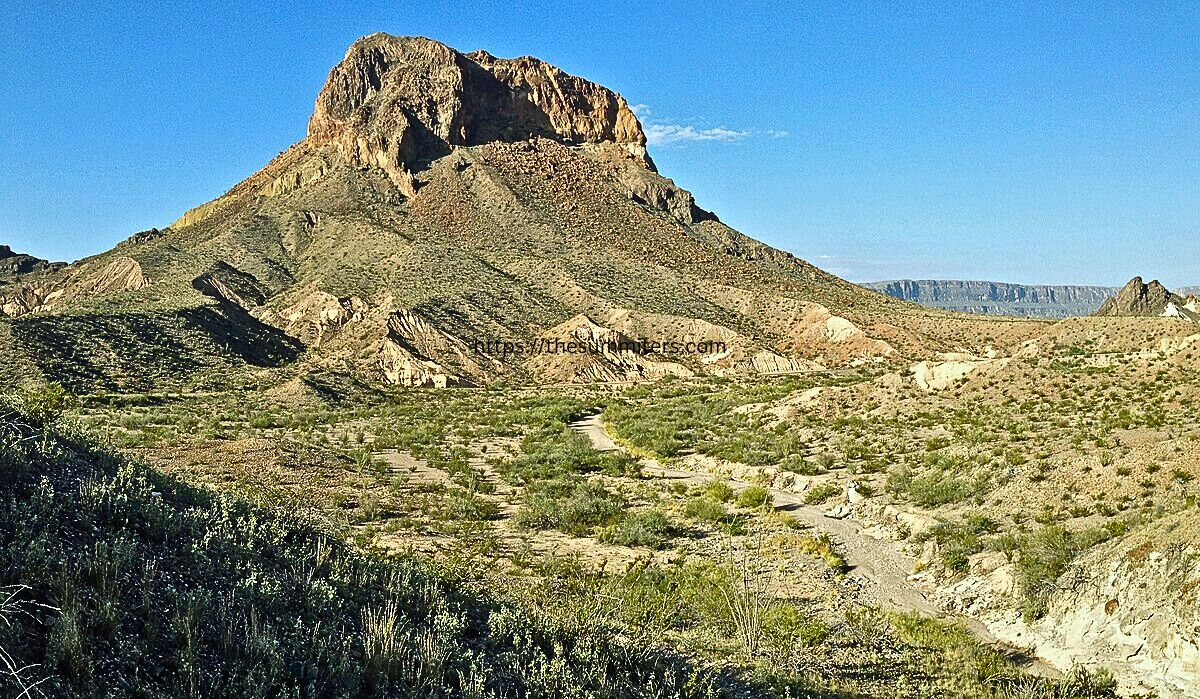
Santa Elena Peak
Situated in the western section of Big Bend National Park, Cerro Castellan emerges as an imposing peak drawing attention with its distinctive presence. With an elevation of 4,835 feet and 1,474 meters,this formidable landmark adds to the park’s diverse and captivating topography. The peak’s geological properties and elevated stature make it a notable attraction for those exploring the western expanses of the park providing both hikers and observers with stunning vistas of the surrounding Chihuahuan Desert. Cerro Castellan serves as a testament to the rugged beauty that defines the varied landscapes within Big Bend, inviting adventurers to appreciate the unique allure of this geological marvel.
Mule Ears
Mule Ears describe by a distinctive pair of twin peaks reminiscent of mule ears stand out as a unique and unmistakable feature within the expanses of Big Bend National Park. Located in the desert region these geological formations capture the attention of visitors with their unique shape and individuality. Although not reaching the towering heights of some of the Chisos Mountains’ peaks Mule Ears possess their own allure, contributing a striking element to the surrounding landscape. These twin peaks have become symbolic of the park’s diverse and captivating geological formations, beckoning exploration and appreciation from those who venture into the desert expanses of Big Bend.
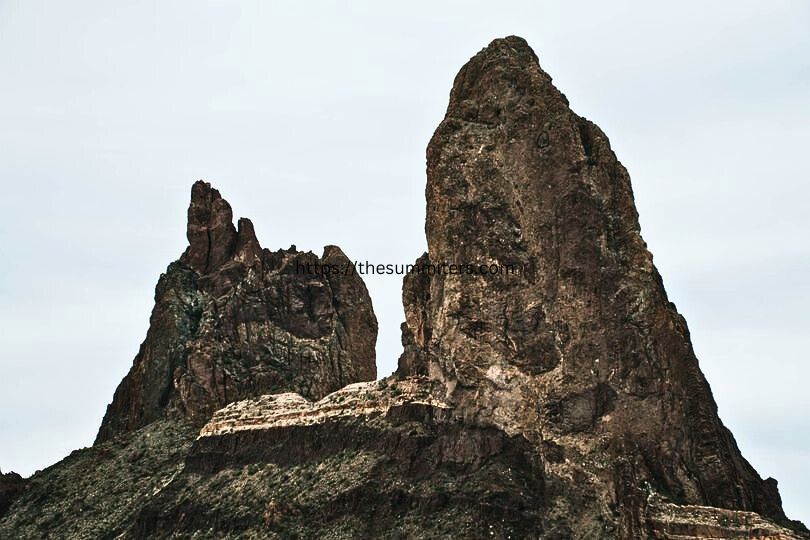
Pulliam Peak
Nestled within the Chisos Mountains Pulliam Peak asserts its presence with an elevation standing proudly at 7,192 feet and 2,192 meters. This notable peak while perhaps not reaching the highest altitudes within the Chisos range, still commands attention with its imposing stature and contributes to the overall rugged beauty of Big Bend National Park. Surrounded by the diverse flora and fauna of the Chisos Mountains, Pulliam Peak offers a unique vantage point for those exploring the park’s extensive trail system. Hikers and nature enthusiasts alike can appreciate the captivating vistas and the sense of elevation that Pulliam Peak provides, making it a distinct and cherished feature within the enchanting landscape of Big Bend.
These peaks offer not only stunning views but also diverse hiking experiences, from challenging ascents to more accessible trails. Hiking enthusiasts and nature lovers often explore these peaks to appreciate the vast beauty and geological wonders of Big Bend National Park.
Hotels and Places to Stay
Renowned for its secluded setting Big Bend National Park has limited place to stay within its borders.Visitors can find a handful of lodging choices within the park itself as well as in nearby towns.
Here are some general types of place to stay!
Chisos Mountains become fixed Inside the Park
The Chisos Mountains become fixed is the only lodging facility within the national park.
place to stay include motel rooms and stone cottages.
Prices can based on the type of room and the season ranging from around $150 to $300 per night.
Terlingua (Near the Park)
The ghost town of Terlingua located near the western entrance of the park offers some fixed options.
place to stay include hotels campgrounds and vacation rentals.
Prices range approximately $80 to $200 or more per night depending on the type of stay.
Study Butte (Near the Park)
Study Butte is another small community near the park entrance with a few stay options.
place to stay include hotels, camping ground, and RV parks.
Prices may vary based on the type of lodging, ranging from approximately $70 to $150 or more per night.
It’s essential to check current prices availability and specific details directly with the accommodations or through online travel platforms as they can be subject to change. Additionally keep in mind that Big Bend National Park is a remote area and lodging options may fill up quickly especially during peak seasons.
Resource: Wikipedia